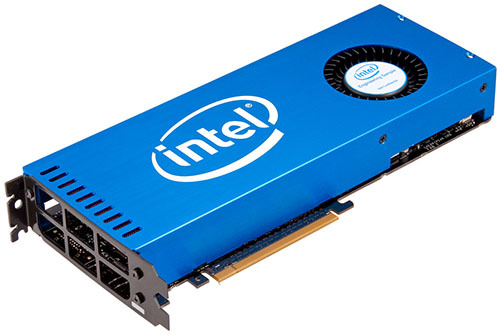Cray Inc launches new generation of supercomputers Cray XС40
In 2012, Cray Inc released the Cray XC30 platform, based on the Intel Xeon E5-2600 processor family. A year later, Intel released the new Xeon E5-2600 V2 chips, and Cray began to use them in the same systems. As a result, we got the same system with more powerful chips. But, as we all know, the improvement of one component is not the way out. Every year demand for speed and productivity grows. And in 2014, another new product from Intel was introduced - Xeon E5-2600 V3 processors. This allowed the company to launch the next supercomputer in the family, the Cray XC40.

Without deviating from tradition, 2 versions of this platform were developed: the Cray XC40, a high-powered machine, and a more budget version of the Cray XC40-AC. Both platforms support DataWarp technology, which speeds up I / O operations by introducing an additional link in the storage subsystem.
')
It is worth paying tribute to the company Cray Inc. Both options can be optionally added to the previously promised accelerators Nvidia Tesla and the coprocessor Intel Xeon Phi. These coprocessors can have up to 61 cores, 244 threads and provide performance up to 1.2 teraflops. This is a great addition to an already powerful system.

The main difference between systems is the number of sockets per cabinet. For Cray XC40, the number of sockets is 384, for Cray XC40-AC it is 128. The number of blades in each blade chassis is the same -16, the only difference is that the Cray X40 system has 3 blades in the cabinet, The XC40-AC is a maximum of 1 chassis.

Cray XC40-AC can be configured into a system of 8 racks with a power of 75 teraflops per rack, while at Cray XC40 this figure is several hundred racks with a total system capacity of 100 petaflops.
The design of the system is the same as that of its predecessor, the difference is only in power. The Cray XC30-AC has a power of 33 teraflops per rack and 66 teraflops for the Cray XC30. Also noticeable is the progress in RAM. Now one compute node contains it from 64 to 256 GB with a capacity of 137 Gbit / s.
In terms of connection, the system has not changed. Like its predecessor, the Aries special purpose integrated circuit is used for routing, through which a maximum of 4 nodes are connected with 48 switch ports with a total bandwidth of 500 Gbit / s.

External Input / Output Interface - Infiniband, 40 and 10 Gigabit Ethernet, Fiber Channel (FC) and Ethernet. The operating system uses the Linux Environment Cray (includes SUSE Linux SLES11, supplemented by HSS and SMW software), Extreme Scalability Mode (ESM) and Cluster Compatibility Mode (CCM)
Security is provided by an integrated Cray Hardware Supervisory System (HSS), an independent network management via an additional channel, full ECC protection of all packet traffic on the Aries network. Also built-in pressure and temperature sensors. Hot swappable blades and power supplies are supported. Both systems can be implemented with air or water cooling to choose from.
The first to be used by the Korean Meteorological Administration (CMA) is the Cray XC40. Cray will also provide the US National Nuclear Security Administration (NNSA) system. As a rule, the US military is always seeking to get the best equipment and advanced technology, and the signed contract between (NNSA) and Cray Inc for the supply of new platforms is the best way to advertise this product.

Without deviating from tradition, 2 versions of this platform were developed: the Cray XC40, a high-powered machine, and a more budget version of the Cray XC40-AC. Both platforms support DataWarp technology, which speeds up I / O operations by introducing an additional link in the storage subsystem.
')
It is worth paying tribute to the company Cray Inc. Both options can be optionally added to the previously promised accelerators Nvidia Tesla and the coprocessor Intel Xeon Phi. These coprocessors can have up to 61 cores, 244 threads and provide performance up to 1.2 teraflops. This is a great addition to an already powerful system.

The main difference between systems is the number of sockets per cabinet. For Cray XC40, the number of sockets is 384, for Cray XC40-AC it is 128. The number of blades in each blade chassis is the same -16, the only difference is that the Cray X40 system has 3 blades in the cabinet, The XC40-AC is a maximum of 1 chassis.

Cray XC40-AC can be configured into a system of 8 racks with a power of 75 teraflops per rack, while at Cray XC40 this figure is several hundred racks with a total system capacity of 100 petaflops.
The design of the system is the same as that of its predecessor, the difference is only in power. The Cray XC30-AC has a power of 33 teraflops per rack and 66 teraflops for the Cray XC30. Also noticeable is the progress in RAM. Now one compute node contains it from 64 to 256 GB with a capacity of 137 Gbit / s.
In terms of connection, the system has not changed. Like its predecessor, the Aries special purpose integrated circuit is used for routing, through which a maximum of 4 nodes are connected with 48 switch ports with a total bandwidth of 500 Gbit / s.

External Input / Output Interface - Infiniband, 40 and 10 Gigabit Ethernet, Fiber Channel (FC) and Ethernet. The operating system uses the Linux Environment Cray (includes SUSE Linux SLES11, supplemented by HSS and SMW software), Extreme Scalability Mode (ESM) and Cluster Compatibility Mode (CCM)
Security is provided by an integrated Cray Hardware Supervisory System (HSS), an independent network management via an additional channel, full ECC protection of all packet traffic on the Aries network. Also built-in pressure and temperature sensors. Hot swappable blades and power supplies are supported. Both systems can be implemented with air or water cooling to choose from.
The first to be used by the Korean Meteorological Administration (CMA) is the Cray XC40. Cray will also provide the US National Nuclear Security Administration (NNSA) system. As a rule, the US military is always seeking to get the best equipment and advanced technology, and the signed contract between (NNSA) and Cray Inc for the supply of new platforms is the best way to advertise this product.
Source: https://habr.com/ru/post/239739/
All Articles